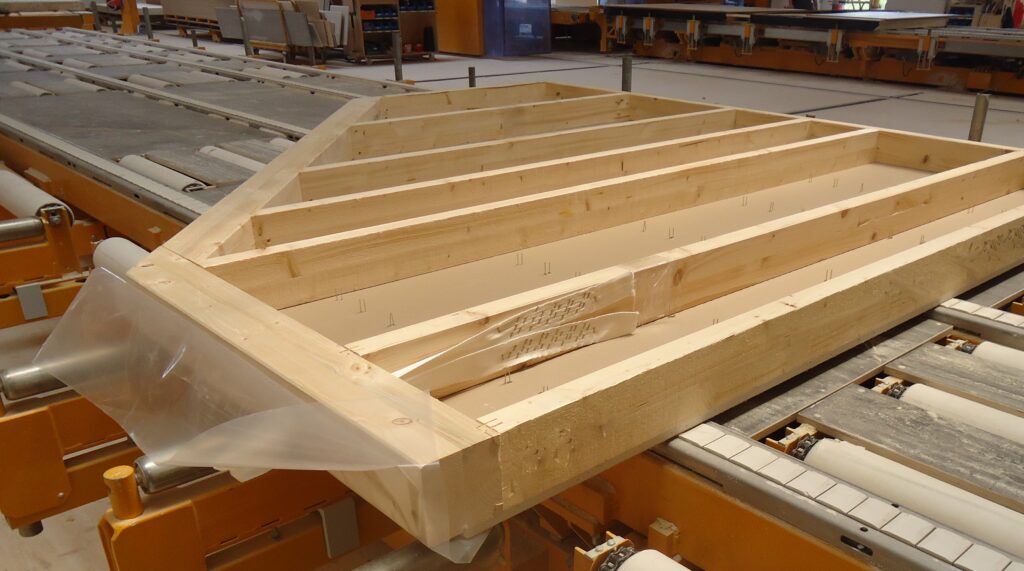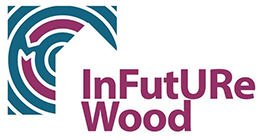
Figure1 load bearing frame of a wood panel construction with nailed butt joints on the frame and steel staples for planking
Michael Risse and Raphaela Ivanica from the Technical University of Munich (Wood Research Munich) answered five questions about timber construction, building documentation and the end-of-life phase of buildings in Germany.
Q1) How high is the share of timber buildings in newly erected buildings in Germany and what is the most common construction method?
In 2018 the construction of 117,869 residential and 27,147 non-residential buildings was approved in Germany. With a total of 20,947 (residential) and 4,832 (non-residential) buildings, timber construction is represented in both areas with a share of almost 18 %. (Destatis 2019).
More than half of the timber buildings are realized in wood panel construction (Fritzen et al. 2014). Other ways of construction used are wooden post and beam construction, half-timber construction and solid timber constructions (block buildings and cross laminated timber (CLT) buildings)
Q2) Which species of wood is commonly used in timber construction in Germany?
In the construction sector, with a share of more than 85 %, most of the wood used is softwood (Mantau et al. 2013) with spruce and pine being the most important wood species. Due to their physical properties, fast growth and local availability, softwood is well established in the construction sector (Steiger 2017). With its strength and elasticity properties, spruce is well adapted as construction timber.
In the last decade, the stock of spruce in Germany decreased by 4 % (48.6 Mio. m³) (BMEL 2018). As described in the study of the Federal Ministry of Food and Agriculture (2018), all other species, especially hardwood species like beech and oak, recorded a strong rise. Therefore, the use of hardwood species in the construction sector to substitute the decreasing availability of softwoods, is an important and ongoing research area.
Research in the field of hardwood use in the construction sector has increased in recent years. In particular, the use of beech as glulam has been investigated in many national research projects. In one set-up, the behavior of low quality beech glulam was investigated (Westermayr et al. 2018).
Q3) What connection types and fasteners are used in timber construction?
In timber construction there is a large range of connection options. Depending on the way of construction, the type of connection and fasteners means to change. Blockhouses or half-timbered house use carpenter’s joints like tongue and groove, dovetail or slot and pivot joints (Steiger 2017). These connections types can be realized without additional fasteners. The connections of timber frame constructions are realized as engineering connections (Steiger 2017). Thereby, the beams are supported with steel brackets and connected with dowels.
For wooden frame constructions, mainly nailed butt joints are used (Steiger 2017). However, it is also possible to use slot and pivot joints, which are sometimes reinforce with screws and adhesives (Kaufmann et al. 2018). For the planking of the wood panel construction, steel nails and staples are used.
Apart from the commonly used types of connections and fasteners, alternative solutions are present on the market. For example, a massive timber constructor from Austria uses wooden dowels to connect the different cross layers in CLT manufacturing instead of adhesives which are normally used (Ing. Erwin Thoma Holz GmbH 2019). Another idea is to join the softwood (butt joints, planking) with wooden nails made of densified laminated beech wood (Korte et al. 2018).
Q4) What is the state of art in the documentation of planning documents?
In Germany, the service phases of the construction process are defined within the framework of the HOAI of 2013, which is divided into nine different service phases. In the annex 10 (re § 34 para. 4, § 35 para. 7 HOAI) the basic services as well as special services of each phase are specified. Therefore, drawings, summary and documentation of results of each phase are basic services. Inventory of properties, 3D or 4D building information modelling (BIM) and further documentation like material passports are declared as special services and must be agreed upon individually.
Additionally, the Federal Ministry of the Interior, Building and Community (BMI) implemented a guideline for sustainable building in 2001. This guideline is a regulation on how public buildings must be built and is intended to serve as a model for private buildings. The main topics of the guideline are: sustainable construction measures, recommendation for sustainable use and operation of buildings and construction in existing contexts (BMI 2019). However, compliance with the guide in the private building sector is voluntary.
Q5) How does the construction sector manage the end-of-life phase (demolition and waste treatment) of buildings?
The most common demolition method in Germany is the selective deconstruction (Schröder and Pocha 2015). The demolition is conducted with heavy devices like excavators and a demolition hammer, which break down the building from the roof to the basement. The demolished materials are separated on site, but no consideration is given to their recyclability.
According to Bilitewski and Härdtle (2013), construction and demolition waste has the highest quality with the demolition method of deconstruction. With this method, the building is dismantled by detaching the connections. Thereby, the materials can be separated without damage or contamination.
The ordinance on the management of waste wood (AltholzV) regulates the classification and treatment of waste wood in Germany. The classification is based on four categories:
- A I (untreated or only mechanically processed)
- A II (glued, painted, varnished or otherwise treated; without organ-halogen compounds or wood preservations)
- A III (halogen-organic compounds in coating; without wood preservation)
- A IV (treated with wood preservatives)
(§2 para. 4 AltholzV)
Load-bearing timber from demolition is usually classified in category A IV. According to the ordinance, material recycling of recovered wood from category A IV is not a permitted end-of-life treatment, hut has to be used thermally (Annex III (re §5 para. 1) AltholzV).
References
Altholzverordnung vom 15. August 2002 (BGBl. I S. 3302), die zuletzt durch Artikel 62 des Gesetztes vom 29. März 2017 (BGBl. I S. 626) geändert worden ist.
Bilitewski, Bernd; Härdtle, Georg (2013): Abfallwirtschaft. Handbuch für Praxis und Lehre. 4., aktualisierte und erw. Aufl. Berlin: Springer. Available online at http://site.ebrary.com/lib/alltitles/docDetail.action?docID=10695455.
Bundesministerium des Inneren, für Bau und Heimat (Ed.) (2019): Leitfaden Nachhaltiges Bauen. Zukunftsfähiges Planen, Bauen und Betreiben von Gebäuden. 3. aktualisierte Auflage. Berlin. Available online at https://www.bmi.bund.de/SharedDocs/downloads/DE/publikationen/themen/bauen/leitfaden-nachhaltiges‑bauen.pdf;jsessionid=1FA0737B3E9E0B068CD998FF9CEF9B91.1_cid287?__blob=publicationFile&v=5.
Federal ministry of Food and Agriculture (2018): The Forests in Germany. Selected Results of the Third National Forest Inventory. 3. korrigierte Auflage.
Fritzen, Klaus; Metzger, Peter; Krämer, Franz Josef (Eds.) (2014): Holzrahmenbau. Bewährtes Hausbau-System. Holzbau Deutschland, Bund Deutscher Zimmermeister. 5., aktualisierte Aufl., korrigierter Nachdruck 2015. Köln: Bruder-Verl.
Honorarordnung für Architekten und Ingenieure vom 10. Juli 2013 (BGBl. I S. 2276).
Ing. Erwin Thoma Holz GmbH (Ed.) (2019): Thoma Holz100 Bauteilkatalog Version 01/2019.
Kaufmann, Hermann; Krötsch, Stefan; Winter, Stefan (2018): Manual of multi-storey timber construction. Munich: Detail Business Information. Available online at http://worldcatlibraries.org/wcpa/oclc/1016769441.
Korte, H.; Koch, G.; Krause, K. C.; Koddenberg, T.; Siemers, S. (2018): Wood nails to fix softwoods: characterization of structural deformation and lignin modification. In European Journal of Wood and Wood Products 76, pp. 979–988.
Mantau, Udo; Döring, Przemko; Hiller, Dirk (2013): Holzeinsatz im Bauwesen – Verwendungsstrukturen nach Gebäuden und Gewerken. In Holger Weimar, Dominik Jochem (Eds.): Holzverwendung im Bauwesen. Eine Markstudie im Rahmen der “Charta für Holz”. Hamburg (Thünen Report 9), pp. 1–69.
Schröder, Marcel; Pocha, Andreas (Eds.) (2015): Abbrucharbeiten. Grundlagen, Planung, Durchführung. Deutscher Abbruchverband. 3., aktualisierte und erw. Aufl. Köln: R. Müller (Bauen im Bestand).
Statistisches Bundesamt (2019): Baugenehmigungen von Wohn- und Nichtwohngebäuden nach überwiegend verwendetem Baustoff. Lange Reihen z. T. ab 1980, checked on 10/29/2019.
Steiger, Ludwig (2017): Basics Timber Construction. Basel/Berlin/Boston: Walter de Gruyter GmbH (Basics Ser). Available online at https://ebookcentral.proquest.com/lib/gbv/detail.action?docID=5159504.
Westermayr, Maximilian; Stapel, Peter; Kuilen, Jan Willem van de (2018): Tensile strength and stiffness of low quality beech (Fagus sylvatica) sawn timber. World Conference on Timber Engineering. Seoul, Republic of Korea, 2018.


